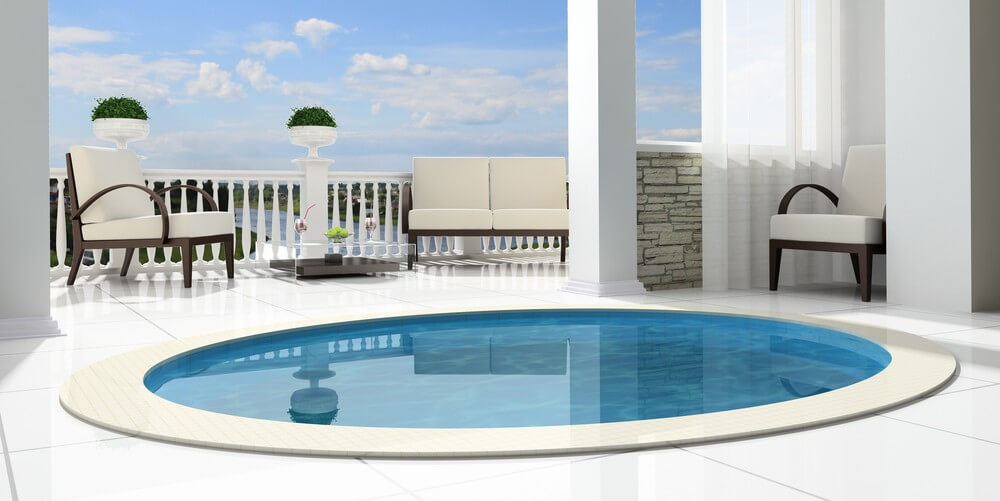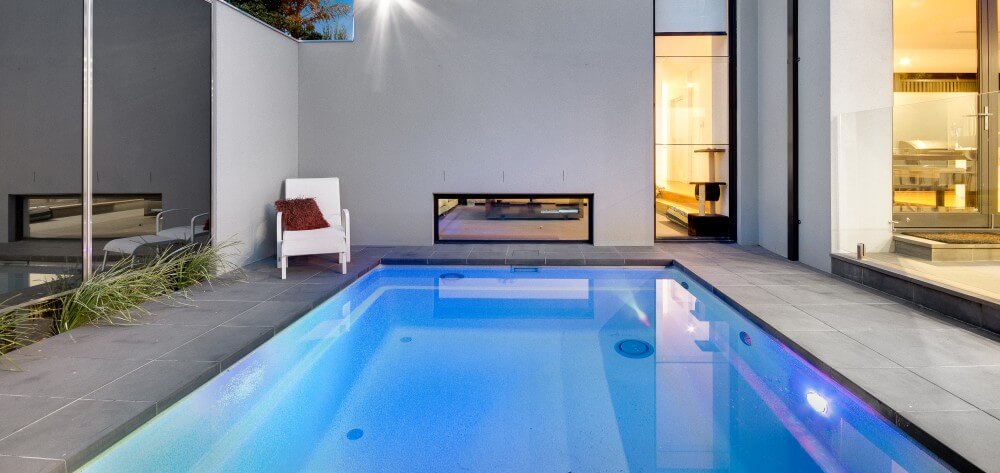With the popularity of Australian plunge pools continuing to grow, we decided to offer an informative guide to help you find out more about them. In this article we cover what is a plunge pool, the various features it can have, the benefits of ownership, and what it costs to have one installed in your backyard. This should help you to make a decision about whether a plunge pool could be the right type of pool for you.
What are plunge pools?
Plunge pools are small pools of usually no more than 6 metres in length and 2 – 3.5 metres wide. The average depth of a plunge pool tends to be around 1.2 metres, although some manufacturers choose to make them deeper, as this gives you more scope for relaxing and exercising in the pool, given its compact size.
In addition, plunge pools are usually fitted with sizeable seating areas, as their main purpose is for relaxation and light exercise rather than intensive swimming. They are also used for plunging into as a way of cooling down in hot weather.
Plunge pools take their name from the pools which form naturally at the bottom of a waterfall. These natural pools have been bathed in for thousands of years as they were believed to have health benefits and rejuvenating properties, and the tradition continues to this day. A modern plunge pool offers you a way to enjoy this relaxing and liberating experience in your own backyard.
What is a plunge pool made of?
The majority of Australian plunge pools are made from either concrete or fibreglass, which are also the most popular materials for constructing larger-scale swimming pools. These are both ideal pool construction materials due to their strength, durability and longevity – a concrete or fibreglass plunge pool can last a lifetime and withstand a wide variety of extreme conditions.
In addition, there are many DIY plunge pool kits available to buy. These plunge pools are usually made from vinyl-liner, a material which is cheaper to buy, but which does not have the strength or durability of fibreglass or concrete. The lining of a DIY plunge pool can easily tear, so it usually needs regular maintenance and repairs, and will have to be replaced completely within a few years, so it does not offer the value for money of a fibreglass or concrete plunge pool.
What features are available for plunge pools?
There are now a great many features which you can purchase as optional extras to improve the functionality of your plunge pool. Among the most popular options are swim jets. These make a lot of sense as an addition to a plunge pool, as the small plunge pool size makes it difficult to do any serious swimming and get a good workout. Swim jets solve this problem by providing resistance in the water, so you can keep swimming in one place and achieve the same health and fitness benefits as if you were swimming laps in a larger pool.
Some plunge pool owners choose to increase their exercise options even further by installing an underwater treadmill or water bike. These can be beneficial for cardiovascular health, as can swimming, so the inclusion of these features enables you to choose which type of exercise you want to take in the pool at a particular time.
Spa jets are also a popular feature for plunge pools. These transform your plunge pool into a spa, providing hydrotherapy on your own property. This has many benefits for wellness, including aiding relaxation, lowering levels of stress and anxiety, reducing blood pressure, and assisting with pain relief and recovery from muscle injuries.
There are also a wide variety of decorative options available for plunge pools, including water features and LED lighting systems, which make your pool look more attractive. Lighting in particular also increases the functionality of the pool, as it enables you to swim at night if you choose.
What does a plunge pool cost to install?
Every pool owner has their own plunge pool ideas, so no two pools are exactly alike. This makes it difficult to estimate the cost, as it depends on a number of factors. These include:
1. How you want your plunge pool installed
Plunge pools can either be installed inground or above ground. An above ground plunge pool is the cheaper option, as there is very little ground preparation work required, and the installation itself can be completed almost instantly.
However, while this is a cost-effective and convenient option, many people prefer the idea of an inground plunge pool, as these usually look better than above ground pools. An inground plunge pool, as its name suggests, is actually built into the ground, so your backyard will need to be excavated, and the installation is a major building job on your property which could take a number of weeks. The result is a pool which looks like a natural part of your property. Inground plunge pools are easier to landscape around, and as they create cleaner lines, they tend to look more attractive than above ground plunge pools. However, as there is so much work involved in the installation, the price tag is significantly higher.
2. The size and shape of your backyard
The small plunge pool size means that they are often installed in backyards where there is not very much space, or the shape is too awkward to support the installation of a full-sized swimming pool. This can often make the building process more difficult, so the price tag tends to reflect this.
The size of your pool is not a major factor in the cost, as the process of installing even a small plunge pool inground is basically the same as installing a full-sized pool, so the amount of work you are paying for is very similar.
3. The material you choose
Concrete plunge pools tend to be more expensive than fibreglass, as they are usually custom built in your backyard. Fibreglass plunge pools are manufactured in a range of standard designs and sizes, enabling you to choose the model which suits you best. The pool shell is then delivered complete, so it does not have to be built on your property.
However, the cost of your plunge pool will depend entirely on the model and the pool company you choose. Some fibreglass plunge pools are similar in price to concrete.
4. The features you add
If you want to include features such as swim jets or spa jets in your plunge pool, this will have an impact on the cost. For every feature, you can expect to add several thousand dollars to your plunge pool cost.
To give you some idea of prices, we have taken a look at the average plunge pool costs in Australia. Without taking any additional features into account, you can have an above ground plunge pool installed for anything between $2,000 and $7,000, depending on the size and model you choose.
If you want an inground plunge pool, you can expect to spend on average $13,000 for a small plunge pool of good quality made by a reputable manufacturer. However, inground plunge pools can cost as much as $50,000, depending on your specifications.
What are the benefits of plunge pools?
Plunge pools are made to the same high quality standards as full-sized swimming pools. This means a plunge pool can be an ideal choice if your backyard is small and you do not have the space for a larger pool. Plunge pools are particularly popular in Australia’s major cities for this reason, as many people who previously thought they could not fit a swimming pool into their backyard have now invested in plunge pools, enabling those with small backyards to achieve the same benefits of pool ownership as those who have more space available.
A plunge pool can vastly improve the design of your backyard, as it gives it a focal point and adds a luxurious element. You can design the rest of your landscaping around the pool to offer maximum functionality and also create a beautiful outdoor area which will add value and enjoyment to your home.
Plunge pools also have obvious benefits for health and wellbeing, especially when spa jets are included to provide hydrotherapy. They can also boost your quality of life by improving your connections with family and friends, as a plunge pool offers a great way to relax and have fun together. It is ideal for families with children, as a small plunge pool is a good environment for getting the kids used to the water, and makes it easier to supervise them in the pool.
Most importantly, a plunge pool offers you the ideal place to relax at home. Plunge pool designs are specifically tailored for relaxation in the water, and the idea is to create your own calm haven in your backyard, enabling you to feel closer to nature and remove some of the stress which has become an integral part of modern life. Owning a plunge pool can remind you of what really matters in life, taking you away from all technological distractions and reconnect with yourself in a tranquil and private setting.
Do you own a plunge pool? Tell us your experiences in the comments below.











